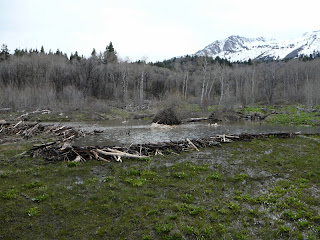4-30
On sunny south-facing slopes a few blueberries are in flower.
John
Welcome
To all those interested in the natural world. Please add your sightings.
In the woods we return to reason and faith-Emerson
Best-Lynn
In the woods we return to reason and faith-Emerson
Best-Lynn
Tuesday, April 30, 2013
Monday, April 29, 2013
Utah wildflowers and beaver dams
4.28.13 On a 6.25 mile hike at 5500 - 6000 feet elevation where the snow has just melted, we found the green grass filled with Glacier lilies, Spring beauties, Fritillaria and yellow Nuttall violets. Low showy Larkspur is just starting to open their delphinium blue blossoms; Mountain Pepperplant with ball-shaped clusters of 4-petalled white flowers on 5-inch stems; Humble Buttercup (aka Unattractive Buttercup); and Dwarf Waterleaf with its lavender ball of bloom resting on the ground filled in spaces.
We came upon a shallow stream that beavers were attempting to dam up. Beavers in an arid land seemed to lack experience: they had placed a primary dam across the stream, but they seemed unsure what to do when they were met with more success than they'd planned and water started spilling out at the side. Their solution was to build another dam, corral-like along the side and added a short V-shaped connection to meet the primary dam. One can see why they may have chosen the site - lots of building material is nearby, and the view can't be beat!
We came upon a shallow stream that beavers were attempting to dam up. Beavers in an arid land seemed to lack experience: they had placed a primary dam across the stream, but they seemed unsure what to do when they were met with more success than they'd planned and water started spilling out at the side. Their solution was to build another dam, corral-like along the side and added a short V-shaped connection to meet the primary dam. One can see why they may have chosen the site - lots of building material is nearby, and the view can't be beat!
Sunday, April 28, 2013
4-28
Rose-breasted Grosbeaks are back.
A few Dwarf Ginseng are in bloom as are Wild Oats and Golden Saxifrage. Golden saxifrage is an obscure, nearly petal-less, miniscule flower of seeps and swamps. Also in those wet areas, tiny white violets - presumably the Northern White Violets that favor such areas - were in abundance.
Cabbage White Butterflies were airborne, as were a few black flies.
John
Rose-breasted Grosbeaks are back.
A few Dwarf Ginseng are in bloom as are Wild Oats and Golden Saxifrage. Golden saxifrage is an obscure, nearly petal-less, miniscule flower of seeps and swamps. Also in those wet areas, tiny white violets - presumably the Northern White Violets that favor such areas - were in abundance.
Cabbage White Butterflies were airborne, as were a few black flies.
John
 |
| Northern White Violet |
 |
| Dwarf Ginseng |
 |
| Wild Oats |
 |
| Golden Saxifrage |
Saturday, April 27, 2013
Thursday, April 25, 2013
4-25
Field Pussytoes attract an abundance of insect life including small blue butterflies - perhaps Eastern Tailed Blues. Unfortunately the butterflies refused to pose for pictures.
Along the river, patches of Wood Anemone were in flower.
And in Newfane, Marsh Marigolds AKA Cowslips blazed along a cold narrow rill. Unmistakable even from a moving vehicle.
John
Field Pussytoes attract an abundance of insect life including small blue butterflies - perhaps Eastern Tailed Blues. Unfortunately the butterflies refused to pose for pictures.
Along the river, patches of Wood Anemone were in flower.
And in Newfane, Marsh Marigolds AKA Cowslips blazed along a cold narrow rill. Unmistakable even from a moving vehicle.
John
Wednesday, April 24, 2013
Sunday, April 21, 2013
Old Bear Scat
Bear scat. O-l-d bear scat in our 1-acre "field." Near my vegetable garden. From last fall?
It's all white now.
Cheryl, Partridge Road
Saturday, April 20, 2013
4-20
Today the swamps were aglow with the tiny paired flower clusters of Spicebush.
A handful of Blue Cohosh flowers could be seen.
A lone wild Strawberry decided that it was time to bloom.
And in a rocky, sheltered niche two Miterworts unfolded their strangely fringed flowers to the new season.
John
Today the swamps were aglow with the tiny paired flower clusters of Spicebush.
A handful of Blue Cohosh flowers could be seen.
A lone wild Strawberry decided that it was time to bloom.
And in a rocky, sheltered niche two Miterworts unfolded their strangely fringed flowers to the new season.
John
Friday, April 19, 2013
4-19
Lots of warblers in the tree tops. The one I got the binoculars on was a Yellow-rumped.
A few Bluets opening.
This little milksnake was, unfortunately, "road kill" on the bike path.
Six-spotted Green Tiger Beetles are on the hunt for insect prey.
And, this patch of Trout Lilies is in its full glory.
John
Lots of warblers in the tree tops. The one I got the binoculars on was a Yellow-rumped.
A few Bluets opening.
This little milksnake was, unfortunately, "road kill" on the bike path.
Six-spotted Green Tiger Beetles are on the hunt for insect prey.
And, this patch of Trout Lilies is in its full glory.
John
Thursday, April 18, 2013
Utah: Migrating waterfowl
4.17.13 We again visited the Bear River Migratory Bird Refuge to view the species that have moved in since the Tundra swans moved on. The temperature was more wintery than spring-like, and a strong wind made the water choppy and seemingly presented a challenge to some of the birds in their attempt to become airborne. Coots were present in great numbers, along with numerous Northern Shovelers, 4 species of Grebes and many other shorebirds. We cautiously drove through a couple flocks of tree swallows that were like swarming mosquitoes. Of particular interest to me - and new-for-me were the American Avocets on their long, slender bluish legs, rust-colored head and neck, and long curved bill. Also new for me were the Yellow-headed Blackbirds. A few of the flocks also contained their relatives, the Red-winged Blackbirds. Check out their call on the Cornell bird site - I think you will agree that if your ear is tuned to the familiar Red-wing, it would be a stretch think this sound is that of a Blackbird! American white pelicans were there in good numbers. By far the largest birds at the refuge, we referred to them as "cruise ships". In spring breeding season, their culmen (bill) becomes a bright red-orange color and a "keel", fibrous growth - or sometimes two- is present. Killdeer and Lesser Yellow-legs shared a mud flat; the classic black-and-white garb of the Bufflehead really stood out in the late day light.
Wednesday, April 17, 2013
4-17
A Dummerston Landing (the extreme NE corner of town) Common Dandelions, Gill-o'er-the-Ground and a Cress (perhaps Mouse-Ear Cress?) were all in flower.
And this caterpillar tentatively identified as that of a Virgin Tiger Moth - a close relative of the Isabella Moth with its familiar Woolly Bear caterpillar - was crossing Carpenter Rd.
John
A Dummerston Landing (the extreme NE corner of town) Common Dandelions, Gill-o'er-the-Ground and a Cress (perhaps Mouse-Ear Cress?) were all in flower.
And this caterpillar tentatively identified as that of a Virgin Tiger Moth - a close relative of the Isabella Moth with its familiar Woolly Bear caterpillar - was crossing Carpenter Rd.
John
Dummerston Conservation members im Marlboro
Several of us joined Alcott Smith into a journey into Marlboro woods. We saw lots of signs of bears. We saw the pawing of white pine trees and just the general disturbance they caused. There were made by 3 cubs. Imagine them "playing" in the woods.
Subscribe to:
Posts (Atom)




+4.28.13+(800x600).jpg)
Ranunculus+inamoenus+4.28.13.JPG)
+4.28.13+(800x770).jpg)
+4.28.13+(800x600).jpg)























+-+Copy.jpg)
+(800x600).jpg)
+(800x600).jpg)
.jpg)
.JPG)
+(800x600).jpg)













